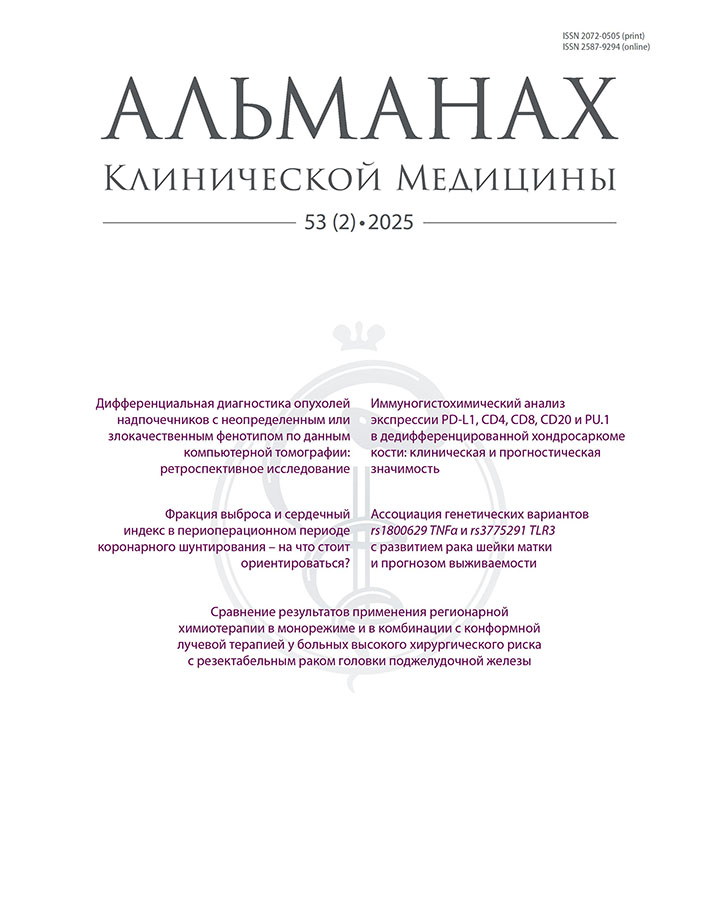Опухоль диафрагмы, симулирующая новообразование желудка: клиническое наблюдение
- Авторы: Бурко П.А.1, Федорова М.Г.2, Ильясов Р.Р.3, Можжухина И.Н.4
-
Учреждения:
- ФГБУ «Национальный медицинский исследовательский центр реабилитации и курортологии» Минздрава России
- ФГБОУ ВО «Пензенский государственный университет»
- ООО «Клиника диагностики и лечения на Измайлова»
- Пензенский институт усовершенствования врачей – филиал ФГБОУ ДПО «Российская медицинская академия непрерывного профессионального образования» Минздрава России
- Выпуск: Том 49, № 7 (2021)
- Страницы: 503-507
- Раздел: КЛИНИЧЕСКИЕ НАБЛЮДЕНИЯ
- URL: https://almclinmed.ru/jour/article/view/1621
- DOI: https://doi.org/10.18786/2072-0505-2021-49-063
- ID: 1621
Цитировать
Полный текст
Аннотация
Подавляющее большинство пациентов с опухолями, исходящими из диафрагмы, не имеют специфических клинических симптомов, что определяет необходимость использования современных методов визуализации, таких как компьютерная (КТ) или магнитно-резонансная томография (МРТ). Это особенно актуально в случаях, когда патологическое образование увеличивается настолько, что оказывает «масс-эффект» на смежные органы. В некоторых ситуациях клинические симптомы злокачественного новообразования возникают из-за местной инвазии в соседние ткани или при формировании отдаленных метастазов. Мы представляем редкое клиническое наблюдение мезенхимальной опухоли диафрагмы у 34-летней пациентки. После анализа клинического статуса и визуализации брюшной полости методами КТ и МРТ был установлен предварительный диагноз «Новообразование неопределенного или неизвестного характера желудка» (D37.1). Вместе с тем было сделано предположение об экзогастральном расположении объемного образования в соответствии с данными МРТ. По результатам обследования коллегиально было принято решение о проведении хирургического лечения посредством лапароскопической резекции. Интраоперационно обнаружена опухоль, исходящая из левого купола диафрагмы. Соответственно, никаких изменений со стороны желудка не обнаружено. Послеоперационный период был без осложнений. Патологоанатомическое исследование, проведенное после резекции опухоли, выявило одиночную кальцинирующую фиброзную опухоль диафрагмы. Приведенный клинический пример показывает, что образование, исходящее из диафрагмы, может имитировать образование, происходящее из дна желудка. Это следует иметь в виду во избежание установления ошибочного диагноза и неверной тактики лечения.
Об авторах
П. А. Бурко
ФГБУ «Национальный медицинский исследовательский центр реабилитации и курортологии» Минздрава России
Автор, ответственный за переписку.
Email: pavelburko@gmail.com
ORCID iD: 0000-0002-1344-9654
Бурко Павел Александрович – врач-рентгенолог отделения лучевой диагностики
121099, г. Москва, ул. Новый Арбат, 32
РоссияМ. Г. Федорова
ФГБОУ ВО «Пензенский государственный университет»
Email: fedorovamerry@gmail.com
ORCID iD: 0000-0003-4177-8460
Федорова Мария Геннадьевна – кандидат медицинских наук, доцент, заведующая кафедрой морфологии Медицинского института
440026, г. Пенза, ул. Красная, 40
РоссияР. Р. Ильясов
ООО «Клиника диагностики и лечения на Измайлова»
Email: diamonddoctor@mail.ru
ORCID iD: 0000-0003-0873-1804
Ильясов Руслан Рамильевич – врач-хирург отделения хирургии
440023, г. Пенза, ул. Измайлова, 71
РоссияИ. Н. Можжухина
Пензенский институт усовершенствования врачей – филиал ФГБОУ ДПО «Российская медицинская академия непрерывного профессионального образования» Минздрава России
Email: mogira1972@yandex.ru
ORCID iD: 0000-0002-0777-1604
Можжухина Ирина Николаевна – кандидат медицинских наук, доцент, заведующая кафедрой рентгенологии
440060, г. Пенза, ул. Стасова, 8A
РоссияСписок литературы
- Gierada DS, Slone RM, Fleishman MJ. Imaging evaluation of the diaphragm. Chest Surg Clin N Am. 1998;8(2):237–280.
- Baldes N, Schirren J. Primary and Secondary Tumors of the Diaphragm. Thorac Cardiovasc Surg. 2016;64(8):641–646. doi: 10.1055/s0036-1582256.
- Weksler B, Ginsberg RJ. Tumors of the diaphragm. Chest Surg Clin N Am. 1998;8(2):441– 447.
- England DM, Hochholzer L, McCarthy MJ. Localized benign and malignant fibrous tumors of the pleura. A clinicopathologic review of 223 cases. Am J Surg Pathol. 1989;13(8):640– 658. doi: 10.1097/00000478-198908000-00003.
- Brunnemann RB, Ro JY, Ordonez NG, Mooney J, El-Naggar AK, Ayala AG. Extrapleural solitary fibrous tumor: a clinicopathologic study of 24 cases. Mod Pathol. 1999;12(11):1034–1042.
- Grancher M. Tumeur végétante du centre phrénique du diaphragme. Bull Soc Anat Paris. 1868;43:385.
- Cheng Y, Zhang C, Gao Y, Dong S. [Rare solitary fibrous tumor of diaphragmatic pleura: a case report]. Zhongguo Fei Ai Za Zhi. 2012;15(1): 59–61. Chinese. doi: 10.3779/j.issn.1009-3419.2012.01.13.
- Kita Y. [Pleural solitary fibrous tumor from diaphragm, being suspected of liver invasion; report of a case]. Kyobu Geka. 2012;65(4):338– 340. Japanese.
- Ge W, Yu DC, Jiang CP, Ding YT. Giant solitary fibrous tumor of the diaphragm: a case report and review of literature. Int J Clin Exp Pathol. 2014;7(12):9044–9049.
- Liu D, Wang Y, Zheng Y, Zhang HL, Wang ZH. Massive malignant solitary fibrous tumor of the diaphragm: A case report. Medicine (Baltimore). 2020;99(5):e18992. doi: 10.1097/MD.0000000000018992.
- Liu CC, Wang HW, Li FY, Hsu PK, Huang MH, Hsu WH, Hsu HS, Wang LS. Solitary fibrous tumors of the pleura: clinicopathological characteristics, immunohistochemical profiles, and surgical outcomes with long-term follow-up. Thorac Cardiovasc Surg. 2008;56(5):291–297. doi: 10.1055/s-2007-965767.
- Lahon B, Mercier O, Fadel E, Ghigna MR, Petkova B, Mussot S, Fabre D, Le Chevalier T, Dartevelle P. Solitary fibrous tumor of the pleura: outcomes of 157 complete resections in a single center. Ann Thorac Surg. 2012;94(2):394–400. doi: 10.1016/j.athoracsur.2012.04.028.
- Ota H, Kawai H, Yagi N, Ogawa J. Successful diagnosis of diaphragmatic solitary fibrous tumor of the pleura by preoperative ultrasonography. Gen Thorac Cardiovasc Surg. 2010;58(9): 485–487. doi: 10.1007/s11748-009-0551-9.
- Enon S, Kilic D, Yuksel C, Kayi Cangir A, Percinel S, Sak SD, Gungor A, Kavukcu S, Okten I. Benign localized fibrous tumor of the pleura: report of 25 new cases. Thorac Cardiovasc Surg. 2012;60:468–473. doi: 10.1055/s-0031-1295519.
Дополнительные файлы








